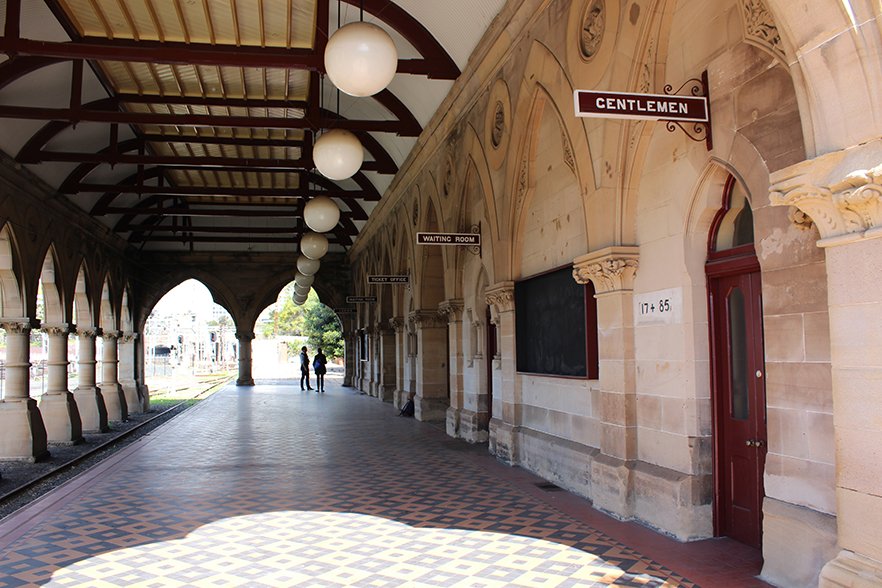End of the line

DURING THE LATE 19th century, mourners would congregate at Mortuary Station, in central Sydney. Twice a day, the city’s funeral train would rumble in towards the platform, through a series of ornate sandstone arches. Coffins would be loaded into special hearse carriages, while suit-clad men, and women dressed in dark-coloured clothing boarded the passenger carriages.
The station’s departure bells would sound and steam would begin to billow across the Sydney skyline as the locomotive chugged into action, slowly moving over the track’s hardwood sleepers. The train’s whistle would shriek as the funeral procession departed, bound for the Rookwood Necropolis, Sydney’s largest cemetery, 17km to the west.
Funeral trains carried mourners from Mortuary to Rookwood for nearly 70 years, from 1869 until 1938. Today, the ghostly whistle of the locos no longer sounds and the platform at Mortuary remains quiet. Situated on Regent Street, at the southern end of the Sydney CBD, the now-disused station is a sombre relic of a long-past era. The elaborate Gothic-inspired building, which appears today much as it would have when it opened 145 years ago, provides a rare architectural glimpse into Sydney’s past. Office blocks and apartment buildings have sprouted in nearby streets, but the church-like station house remains, recalling a time when Sydney’s funeral processions were public events.

The architects and artists “spared nothing” during the build of the station, says historian Bill Phippen. Funeral trains passed through Mortuary for more than 60 years, but today it is only used for the occasional function. (Image: John Pickrell)
During the late 1800s and early 1900s, mortuary trains operated in many large cities, including Sydney, Melbourne, London and Berlin. “At the time, personal forms of transport were much rarer,” says Trevor Howells, a lecturer at the University of Sydney’s Faculty of Architecture. “Because the train was a public form of transport, funerals were a more formalised and more public process of mourning.”
Mortuary Station was built in 1869 to transport mourners and their dead to Rookwood. The Devonshire Street Cemetery, located beneath present-day Central Station, had been in use since the early 1800s and was almost full. “The city was suffocating in cemeteries,” says Bill Phippen, of the Australian Railway Historical Society.
A new cemetery needed to be built beyond the city centre, where space was available. Rookwood was chosen as the site and Rookwood Necropolis, originally called Haslem’s Creek Cemetery, was opened in 1867. “The railway was the means of freeing up space in the city,” says Bill. However, the cemetery’s distance from the city meant it was impractical for a horse-drawn hearse and its entourage of mourners to walk the full 17km. A dedicated funeral train provided the solution to this problem.

The sweeping decorative elements and gothic-architectural designs were a nod to religion and churches. (Image: John Pickrell)
The colonial government commissioned the construction of two stations: Mortuary, on Regent Street, and the Receiving House, at Rookwood. Well-known colonial architect James Barnet designed both structures. Mortuary was built using Pyrmont sandstone by prominent construction company Stoddart & Medways, and adorned with angels, cherubs and gargoyles, which were carved by sculptors Thomas Duckett and Henry Apperly. The station was officially opened on 29 June 1869.
“It’s such a grand building,” says Bill. “It is a relic of another age.”
During its heyday, Mortuary Station was a bustling place. Ticket prices varied; in 1927, a regular adult fare cost about 40c. Discounts were given for poorer passengers and the dead travelled free. Up to 30 coffins could be loaded into each hearse carriage, which was located at the rear of the train. As well as carrying mourners, the front carriages would be stacked with supplies for the wakes. Funeral attendants would load cases of beer and spirits, and food items such as meat pies, bread and cheese, and seafood – including oysters, lobsters and crabs – onto the carriages. Often, the funeral celebrations would begin before the trains arrived at Rookwood.
By 1938 roads had improved and times were changing – motor cars were fast becoming the preferred form of transport and the funeral trains stopped running from Mortuary. The station was renamed Regent Street, and, between 1938 and 1950, it was used as a loading platform for trains that transported livestock including horses, dogs and poultry. After this, it was used as a parcel dispatch centre until 1981, when it was declared a national heritage site. In 1985 the State Railway Authority spent $600,000 on restoring the sandstone building to its original glory.
Aside from being used for the occasional wedding photo shoot or commercial event, Mortuary now remains closed behind locked wrought-iron gates. Day and night, traffic streams through the busy six-lane intersection out the front, while hundreds of electric trains glide past the abandoned platform. At dusk, the lights that hang from the roof of the platform flicker on automatically, but there will be no passengers arriving anytime soon.
This article was originally published in the Jan-Feb 2015 issue of Australian Geographic (AG#124).
READ MORE:




